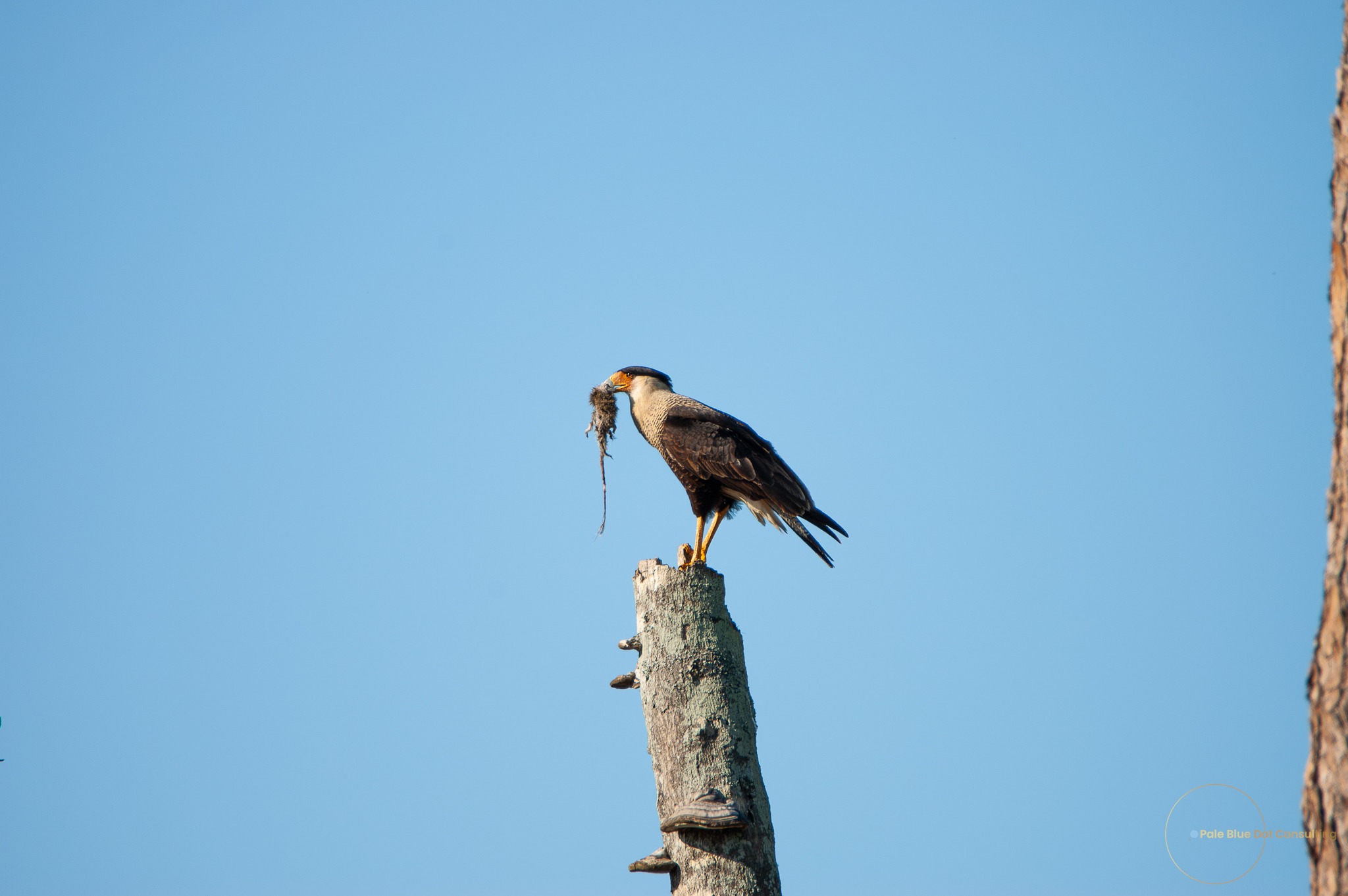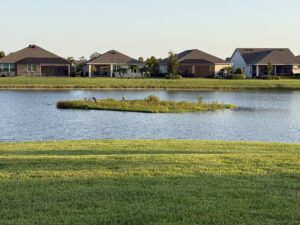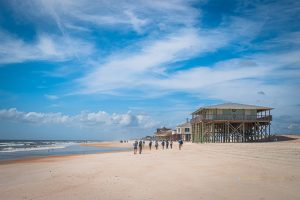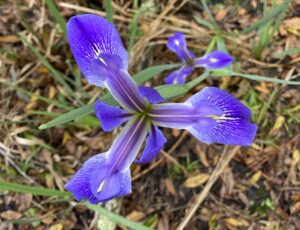In the vast, sun-drenched prairies of Florida, a striking bird of prey soars low over the grasslands, its wings broad and deliberate, its sharp eyes scanning the earth below. The Crested Caracara (Caracara plancus; Northern Crested Caracara, subspecies C. p. cheriway) is a bird of contradictions — a falcon that behaves like a vulture, a scavenger with the regal bearing of an eagle. With its bold black-and-white plumage, fiery orange face, and a distinctive crest that lends it an almost prehistoric appearance, the caracara is one of Florida’s most fascinating yet often overlooked raptors.
Unlike the swift, aerial hunters of the falcon family, caracaras are ground foragers, striding across open landscapes with surprising confidence. They are social birds, often seen in pairs or small family groups, and their raucous calls echo across the plains. But despite their adaptability, caracaras face significant threats from habitat loss, making them a federally protected species under the Endangered Species Act. For developers and landowners in Florida, understanding the caracara’s ecology and legal protections is critical to ensuring both conservation and compliance.
This blog explores the life history of the caracara, its stronghold in Florida, and the permitting challenges that arise when developing land in its habitat.
The Caracara’s Life History: A Falcon Unlike Any Other
Physical Characteristics and Behavior
At first glance, the Crested Caracara could be mistaken for a hawk or even a small eagle. Its dark body contrasts sharply with a white neck and tail, while its bare, orange-red face gives it a distinctive, almost vulture-like appearance. The most striking feature is its black crest (hence its name), which it raises when alert or agitated (although some affectionately call this crest a toupee).
Unlike most falcons, which rely on speed and aerial hunting, caracaras are opportunistic feeders. They walk boldly across open ground, flipping over debris with their beaks in search of insects, reptiles, and small mammals. They are also scavengers, often seen feeding on carrion alongside vultures, and notably following large agriculture equipment cutting grass, tilling soil, or harvesting crops, as these machines stir up bugs and other critters. This adaptability allows them to thrive in Florida’s ranchlands and prairies, where they coexist with cattle and other grazing animals.
Breeding and Nesting Habits
Caracaras are monogamous, forming long-term pair bonds. Their courtship displays include dramatic aerial chases and loud, rattling calls. Nesting season in Florida typically runs from December to May, though some pairs may breed earlier or later depending on conditions.
They build large stick nests, often in cabbage palms or other tall trees, though they have been known to use artificial structures in treeless areas. Both parents share incubation duties, and the young fledge after about 8–10 weeks. Remarkably, young caracaras may stay with their parents for months, learning to forage and navigate their territory before striking out on their own.
Lifespan and Survival Challenges
In the wild, caracaras can live 15–20 years, but their survival depends heavily on habitat availability. Unlike many raptors that thrive in forests or wetlands, caracaras require open, mostly treeless landscapes, precisely the kind of land that is increasingly converted for agriculture, urban development, or solar farms.
Road mortality is another significant threat, as caracaras frequently feed on roadkill. Additionally, illegal shooting and pesticide exposure (from scavenging poisoned carcasses) have contributed to population declines in some areas.
Where Caracaras Reside in Florida: The Last Strongholds
Florida is one of the few places in the United States where the Crested Caracara can still be found in significant numbers. Their range is concentrated in central and south Florida, particularly in expansive, open habitats such as:
– Kissimmee Prairie Preserve State Park: One of the best places to observe caracaras, this vast grassland provides ideal foraging and nesting grounds.
– Avon Park Air Force Range: Military lands often serve as unintentional wildlife sanctuaries, and caracaras thrive here.
– Myakka River State Park: Though more wooded than other habitats, the open prairies here and in surrounding counties support a small caracara population.
– Big Cypress National Preserve & Everglades: Wetlands and adjacent ranchlands provide critical habitat.
Caracaras are particularly associated with cattle ranches, where grazing maintains the open landscapes they prefer. Interestingly, some of Florida’s best caracara habitat exists on private ranchlands — meaning conservation efforts must balance agricultural use with wildlife protection.
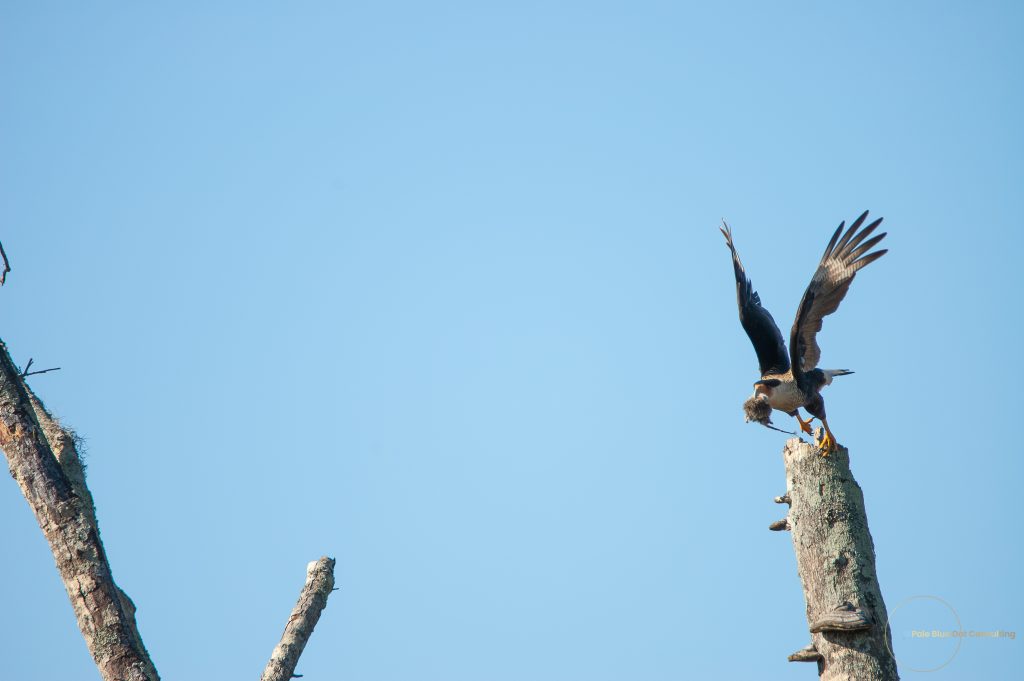
A Species in Peril: Why Protection Matters
The Florida population of the Crested Caracara is listed as threatened under the Endangered Species Act (ESA), meaning any activity that harms the birds or their nests can result in legal penalties. Additionally, they are protected under the Migratory Bird Treaty Act (MBTA), which prohibits the destruction of active nests.
Habitat loss remains the greatest threat to caracaras. As Florida’s human population grows and sprawls inland, grasslands and pastures are converted to housing developments and industrial sites. Without careful planning, these changes could push caracaras toward local extinction.
Developing Near Caracara Habitat: Permitting and Best Practices
For developers, landowners, and government agencies, building near caracara habitat requires navigating federal wildlife regulations. Failure to comply can lead to project delays, fines, or even legal action. Below is an overview of the permitting process and best practices for minimizing impacts.
Step 1: Conducting a Habitat Assessment
Before any ground is broken, ecologists must survey the property to determine if caracaras or quality habitat are present. Key indicators include:
– Nests (large stick structures in palms or tall trees)
– Foraging behavior (birds walking on the ground, feeding on carrion)
– Vocalizations (loud, rattling calls)
If caracaras are confirmed, the next step is consultation with the U.S. Fish & Wildlife Service (USFWS).
Step 2: Avoiding Nesting Season (December–May)
If active nests are found, no disturbance is permitted until chicks have fledged. Clearing land during nesting season can result in abandoned nests and dead chicks, which violates the ESA.
Step 3: Applying for an Incidental Take Permit (ITP)
If development cannot avoid harming caracaras or their habitat, an Incidental Take Permit (ITP) under Section 10 of the ESA may be required. This involves:
– Developing a Habitat Conservation Plan (HCP) – Outlining how impacts will be minimized.
– Mitigation Measures – Such as preserving adjacent habitat, creating artificial nesting sites, or funding conservation programs.
Best Practices for Developers
To reduce conflicts with caracaras, developers should:
– Preserve open foraging areas where possible.
– Avoid removing lone trees that could serve as nest sites.
– Implement speed limits in caracara zones to reduce roadkill.
– Work with conservation groups to offset habitat loss.

Conclusion: Balancing Growth and Conservation
The Crested Caracara is more than just a bird, than just a fancy buzzard — it is a symbol of Florida’s vanishing wild prairies. Protecting this species requires cooperation between developers, biologists, and government agencies. By following federal guidelines and adopting wildlife-friendly practices, we can ensure that caracaras continue to soar over Florida’s landscapes for generations to come.
For landowners planning projects in caracara territory, early consultation with the U.S. Fish & Wildlife Service is essential. Likewise, bird enthusiasts can support conservation by visiting protected areas like Kissimmee Prairie Preserve, where these magnificent raptors still rule the grasslands.
How Ranchers Are Partnering with Wildlife Agencies
1. Conservation Easements: Paying Ranchers to Protect Habitat
Many Florida ranchers have enrolled in USDA and USFWS programs that pay them to maintain caracara-friendly landscapes. Examples include:
– The Wetlands Reserve Program (WRP) – Restores prairie wetlands.
– The Environmental Quality Incentives Program (EQIP) – Funds sustainable grazing practices.
2. The “Caracara-Friendly Ranching” Certification
Audubon Florida and the Florida Cattlemen’s Association created a certification program that rewards ranchers for:
– Preserving nest trees (like cabbage palms).
– Avoiding pesticides that could poison caracaras.
– Reporting caracara sightings to biologists.
3. Research Collaborations
Ranchers have allowed researchers to:
– Tag and track caracaras to study movement patterns.
– Test non-lethal predator control methods (reducing the need for poison).
For landowners and developers, the key takeaways are:
✅ Survey early for caracaras before breaking ground.
✅ Work with USFWS to design wildlife-friendly projects.
✅ Explore conservation incentives like easements and certifications.
For bird lovers, supporting conservation ranching and habitat protection programs is the best way to ensure caracaras remain a living symbol of wild Florida.
Funding Opportunities for Ranchers Protecting Caracara Habitat
Florida’s ranchers play a vital role in caracara conservation. These programs provide financial incentives:
1. Federal Conservation Programs
| Program | Administered By | Benefits | Annual Funding Range |
|---|---|---|---|
| EQIP (Environmental Quality Incentives Program) | USDA NRCS | Pays for sustainable grazing systems, nest tree protection | $5,000−50,000 |
| WRE (Wetlands Reserve Easements) | USDA NRCS | Permanent easements for prairie wetlands | Varies by acreage |
| Partners for Fish and Wildlife | USFWS | Cost-share for habitat restoration | Up to $100,000/project |
2. State & Private Programs
– Florida Forever Program
Purchases conservation easements on working ranches at fair market value
– Caracara Habitat Stewardship Grants (National Fish and Wildlife Foundation)
Provides $10,000-$250,000 for:
– Prescribed burns to maintain open habitat
– Invasive species control
– Nest site enhancement
– Sustainable Ranching Initiative (Audubon & Beef Producers)
Offers $150/acre/year for ranchers who:
– Maintain grazing regimes benefiting caracaras
– Protect known nest sites
– Participate in monitoring
Caracaras and Development: Case Studies in Conservation and Collaboration
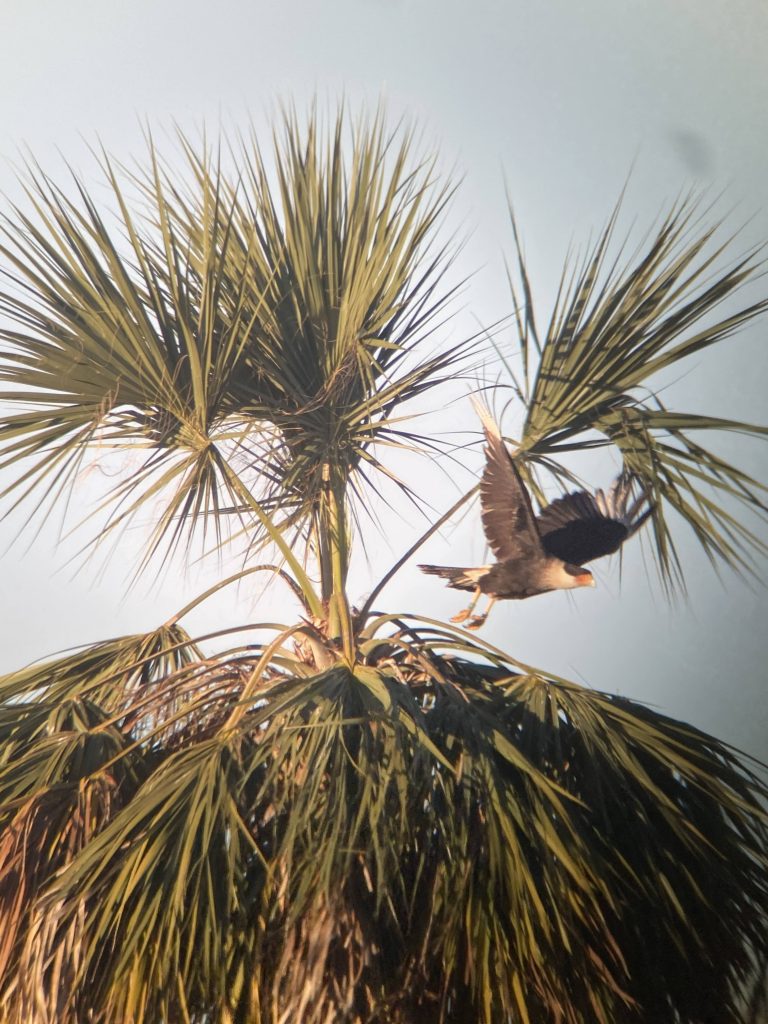
The Crested Caracara’s survival in Florida depends on a delicate balance between human activity and habitat preservation. As development expands into the state’s last remaining prairies and ranchlands, conflicts arise — but so do innovative solutions. Below, we explore real-world case studies where caracara conservation clashed with or adapted to development, as well as how ranchers are partnering with wildlife agencies to protect this iconic species.
Case Study 1: The DeSoto Solar Project – A Model for Mitigation
The Challenge
In 2018, plans for the DeSoto Solar Energy Center—a 300-megawatt solar farm in DeSoto County, Florida—threatened critical caracara habitat. Surveys confirmed that the site was home to multiple nesting pairs, raising concerns about displacement and habitat fragmentation.
The Solution
Rather than abandoning the project, the developers (Florida Power & Light and NextEra Energy Resources) worked with the U.S. Fish & Wildlife Service (USFWS) to implement a Habitat Conservation Plan (HCP). Key measures included:
– Relocating solar panels away from active nests during breeding season.
– Preserving adjacent grasslands as permanent foraging habitat.
– Funding long-term caracara monitoring in partnership with Audubon Florida.
The Outcome
The DeSoto Solar Project became one of the first large-scale energy developments in Florida to successfully minimize impacts on caracaras while still proceeding with construction. This case set a precedent for future solar farms in caracara territory, proving that renewable energy and wildlife conservation can coexist.
Case Study 2: The Babcock Ranch Development – Balancing Growth and Preservation
The Challenge
The Babcock Ranch in southwest Florida is one of the largest remaining contiguous habitats for caracaras. When the state sold part of the land for a 17,000-acre mixed-use development, conservationists feared the worst.
The Solution
The developers (Kitson & Partners) and state agencies agreed to a 90,000-acre conservation easement, ensuring that the majority of the ranch remained undeveloped. Additionally:
– Critical caracara nesting zones were mapped and protected.
– Cattle grazing was maintained to keep the landscape open (benefiting both ranchers and caracaras).
– Wildlife corridors were established to connect fragmented habitats, including being added to the existing Florida Wildlife Corridor.
The Outcome
Today, Babcock Ranch is a national model for sustainable development. The caracara population has remained stable, and the ranch continues to support both wildlife and responsible land use.
Case Study 3: Road Mortality and the USFWS “Caracara Safe Passage” Initiative
The Challenge
Caracaras are highly vulnerable to vehicle collisions because they feed on roadkill. In Highlands and Glades counties, road mortality was a leading cause of death.
The Solution
The USFWS partnered with the Florida Department of Transportation (FDOT) to implement:
– “Wildlife Crossing Zones” with reduced speed limits in high-risk areas.
– Roadside carcass removal programs to reduce scavenging temptation.
– Public awareness campaigns to educate drivers about caracaras.
The Outcome
Since the program’s launch in 2020, caracara roadkill incidents have dropped by 40% in targeted areas.
Case Study 4: The Adams Ranch Partnership
This 30,000-acre Okeechobee ranch became a model for caracara coexistence by:
1. Enrolling in EQIP to fund water retention systems
2. Establishing a 5,000-acre conservation easement
3. Hosting researcher radio-tracking studies
“The payments help offset our costs, and we’re proud to maintain habitat for these special birds,” says ranch manager Tom Hammond.
Take Action Today
Whether you’re a landowner, birder, or concerned citizen, you can help:
🔹 For rancher programs: Reach out to USDA NRCS Florida offices or USFWS’s South Florida ECO office
🔹 For wildlife surveys, caracara nest monitoring, and permitting assistance: contact Audubon Florida (at (407) 644-0190 or visit fl.audubon.org) or reach out to us at Pale Blue Dot Consulting (all photos on this page, and throughout our site and social media, were taken by PBDC ecologists during caracara nest monitorings or other wildlife surveys).
“The caracara’s future depends on this collaboration between private landowners and conservationists,” emphasizes Dr. Mark Smith, University of Florida wildlife ecologist. “Every protected acre makes a difference.”
How Citizens Can Help Monitor Florida’s Caracaras
Florida’s caracara population needs ongoing monitoring to ensure their protection. Here’s how you can contribute:
1. Join Organized Survey Efforts
– Audubon Florida’s Caracara Watch Program
Volunteers receive training to conduct seasonal surveys in key habitats. Participants document:
– Nest locations
– Breeding behavior
– Threats like illegal shooting or habitat destruction
– Florida Fish and Wildlife Conservation Commission (FWC) Reporting
Citizens can submit caracara sightings through:
– FWC’s Rare Species Reporting System
– iNaturalist (Florida Caracara Project)
2. Adopt-a-Nest Program
Modeled after successful eagle monitoring initiatives, this program trains volunteers to:
– Monitor known nest sites during breeding season
– Record chick development and fledging success
– Report disturbances to wildlife authorities
“Last season, our Adopt-a-Nest volunteers documented 17 successful fledglings in Polk County alone,” reports Maria Rodriguez, Avian Conservation Specialist with Audubon Florida.
3. Roadkill Monitoring
Since vehicle strikes are a major threat, volunteers can:
– Identify caracara roadkill hotspots
– Work with county road crews to remove carcasses quickly
– Advocate for wildlife crossing signage
Training Opportunities
– Annual Caracara Conservation Workshop (Hosted by Archbold Biological Station)
– Online Raptor Identification Courses (Offered by the Cornell Lab of Ornithology)
